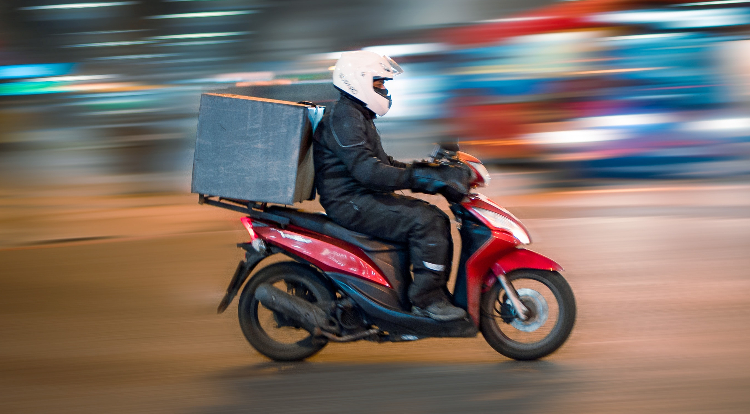On a hot, steamy summer day, with lunchtime approaching, what would you do: dress up and head out to buy groceries, get gross and sweaty, or chill at home, pull out your phone, and put in a quick and easy order on UberEats?
As we are a generation spoiled by the convenience of the internet, it is reasonable that more people would choose the second option.
When we discuss FoodPanda or UberEats, the first thing we think of is the convenience these platforms offer; however, what really are the benefits of food delivery apps, and what negative effects might they cause? Here are some of the pros and cons of food delivery services:
Pros
The fundamental reason behind the rise of food delivery is that it makes people’s lives much easier, and it achieves this goal in the following ways.
Food delivery apps save users time
Apart from saving the effort of getting dressed and wandering outside to decide what to eat, the real beneficiaries of food delivery are busy people who used to skip meals due to their demanding schedules. Once FoodPanda and UberEats became available, these people could finally eat regularly thanks to the time saved from not having to wait in line at a restaurant.
Food delivery apps offer more variety
Just take a look at the number of restaurants in the apps: there are already 42 thousand restaurants or stores in Taiwan in cooperation with UberEats. Now our choices are no longer limited to nearby restaurants. Instead we have a whole new range of options.
Food delivery apps help small businesses and gig workers
Food delivery not only gives smaller restaurants higher visibility, it has also opened up brand new work opportunities for people who are looking for jobs. Research estimates that 3-4 million self-employed UberEats drivers worldwide deliver meals to customers. The successful recruiting of members in the delivery industry undoubtedly decreases unemployment rate and contributes to economic growth.
Cons
The pros of food delivery provides a clear change in people’s lifestyles, but now let’s look at the costs we need to pay for this particular service.
Food delivery apps contribute to poor eating habits
What is the first restaurant that pops up on your delivery app page? Pizza Hut? McDonalds? KFC? All of it is junk food isn’t it? Food delivery platforms make junk food more accessible since they are often the most popular choices that appear at the top of the page. In fact, 75 percent of foods on UberEats are unhealthy, thus proving how people are more likely to choose unhealthy food options online.
Food apps can cause businesses to struggle
Although food delivery apps help local restaurants gain visibility and provide work opportunities, the third party apps also take away a large cut of profit from both customers and restaurants. According to Giuseppe Badalamenti, owner of a pizza shop in San Francisco, “What started as $1,042.63 in food sales was reduced to $376.54 after Grubhub fees for delivery, commission, processing and promotions.”
Not only do delivery apps overcharge businesses, gig workers are also taken advantage of due to the fact that they are all “independent contractors” who can, in theory, independently choose which orders to accept and where and when to accept them. These workers typically only collect between 15 to 30 percent in delivery fees. This shows that food delivery apps are basically scamming restaurants, delivery drivers, and even customers by overcharging them.
Food apps promote waste
Recall the last meal you ordered from UberEats. How was it packaged? How many plastic bags, disposable chopsticks, disposable bowls, plastic spoons, plastic containers, and plastic cups were there? Probably a lot more than what you would get if you ate at the restaurant. Since people nowadays value convenience and efficiency more than anything else, we often overlook this excessive waste that is burdening our environment.
Another concern is harm caused by transportation. There is obviously no way most delivery workers take eco-friendly public transportation. They ride scooters or drive cars. In Taipei, thousands of scooters are dedicated to delivering food across the city, all day every day. The amount of pollution they are generating right now as we speak is astounding.
Fixing the problem
The government should implement a certain degree of regulation to control the amount of orders people are requesting. Monthly quotas for each customer account or weekly limitations for orders are both possible.
Also, the government should request delivery apps to evaluate their users, with students allowing less access and busy workers with more. This evaluation process can help the government target those who are only using the apps because they are lazy but not for actual needs.
Another thing the government could do is educate the public about the effects of food delivery, which would lead to more public awareness and thus lessen the use of these delivery apps.
Of course, sometimes we just feel lazy and it’s okay to lay back and let the food come to you; but keep in mind that we should balance the times we use the service for both our own and the environment’s good.
– –
All in all, the food delivery industry has become one of the most popular and most-used services of modern times. Along with the benefits of these platforms, it is important for us to realize how these apps are causing social and economic harm.





0 Comments